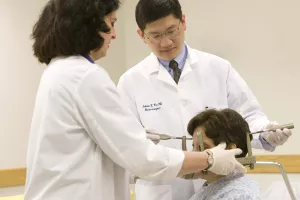We turn to neurovascular surgery for treating people who’ve experienced blood vessel conditions like an aneurysm or stroke. It involves operating on blood vessels that supply blood to the brain and spinal cord (cerebrovascular surgery) with minimally invasive approaches using catheters (endovascular surgery).
Supporting your neurovascular system with surgical precision
The neurovascular system is the network of blood vessels that supply blood to the brain and spinal cord. Conditions like a brain aneurysm or stroke can throw the neurovascular system off balance, and even lead to life-threatening effects.
When your neurovascular needs are anything but average, our surgeons are here to overdeliver. We use the latest minimally invasive techniques — like Gamma Knife surgery and catheter-based (endovascular) procedures — to restore healthy harmony to your blood vessels and nervous system.

Conditions
You can trust us to detect and surgically treat the full range of neurovascular conditions, including:
Brain aneurysm
A brain aneurysm is a weakened wall of an artery located in or around the brain that bulges or "balloons" with blood. Just like a balloon, this weak spot can only expand from blood pressure for so long before it pops, or ruptures.
A ruptured artery is life-threatening because it allows blood to flow directly into the brain, leading to long-term brain damage, stroke or death.
Knowing your family history is one of the most powerful tools for determining your risk of an aneurysm. If 2 or more family members have had aneurysms, your care team will keep a close eye on your neurovascular system.
Talk with your doctor about how you could possibly benefit from cutting-edge diagnostics like computational fluid dynamics or preventive procedures to stop aneurysms before they begin.
Stroke
A stroke occurs when blood supply to the brain is cut off or when there’s bleeding in the brain. Within minutes of a stroke, brain cells begin to die. It’s extremely important to know the signs of a stroke and get emergency care as soon as you see them.
Testing
To get a clear view of your arteries, blood vessels and the nearby structures in and around your brain, we use imaging tests like:
- CT scan
- Magnetic resonance angiography (MRA)
- MRI
- Transcranial doppler (TCD) ultrasound
Computational fluid dynamics
Most brain aneurysms don't show symptoms, so it can be tricky to detect them before they're a problem. But it is possible.
We’re working on a way to predict possible aneurysms using the power of aerospace engineering. This technique is called computational fluid dynamics.
Computational fluid dynamics was originally created to study airflow over aircraft wings. We can apply the same idea to your arteries by looking at how blood flows through the brain’s blood vessels to determine your risk level.
Treatments
Before deciding on a cerebrovascular or endovascular procedure, our neurosurgery team will look at your current condition, family history and health goals to create a treatment path that’s uniquely you. Here’s how the 2 surgical options stack up:
- Cerebrovascular surgery, also known as neurovascular surgery, performs surgery on the blood vessels that pump blood to the brain.
- Endovascular surgery uses catheters to perform minimally invasive procedures. Rather than making an open incision, endovascular procedures involve making small punctures in the skin, then threading catheters through arteries and blood vessels to treat the affected area.
Together with you and your loved ones, we’ll take the time to explain your treatment options, the risks and benefits of each procedure and what to expect during recovery.
Surgeries to treat brain aneurysms
We often look to surgery to prevent or relieve bleeding in the brain caused by brain aneurysms. Whenever possible, we’ll use minimally invasive methods to help fast-track your road to recovery.
One of the most common ways we treat aneurysms is with a minimally invasive endovascular treatment called coiling. Here's what to expect during this procedure:
- We make a small incision in your groin area close to the femoral artery.
- We insert a catheter into a blood vessel over the femoral artery.
- We snake the catheter through the bloodstream and into the brain's blood vessels.
- One by one, the coils are threaded through the catheters and into the aneurysm.
These coils fill up the aneurysm and create a clot, preventing blood from flowing into it and reducing the risk of it bursting.
When an aneurysm has a wider opening, we use a technique called stent-assisted coiling. We place a stent (a tiny mesh tube made of metal) in the blood vessel next to the aneurysm to support the coils and give greater protection from rupture.
Also known as “clipping,” this procedure starts by making a small opening in the skull. The surgeon then inserts a microscope through the skull to locate the affected blood vessel and place a clip across the aneurysm. This clip prevents blood from flowing into the aneurysm and protects you from complications of a potential rupture.
Flow diverting embolization devices are stents that we place in the main blood vessel containing the aneurysm. These stents shift blood flow away from the aneurysm. This allows the blood vessel wall to heal and gives it the space to form a new lining.
Surgeries to treat strokes
When treating a stroke, time is of the essence. We’ll do everything we can to quickly and safely restore blood flow to the brain.
When a stroke is caused by a narrowing of the arteries in the brain due to plaque buildup, we often look to angioplasty. An angioplasty is a minimally invasive endovascular procedure that widens any narrowed or blocked arteries.
During this procedure, we’ll thread a tiny balloon through a catheter until we reach the affected artery in the brain. As this balloon expands, it widens the artery for better blood flow.
Endarterectomy is a common treatment strategy for when a stroke occurs in the carotid arteries (the main arteries in the neck that supply the brain with blood). During this procedure, the surgeon opens the narrowed artery and carefully cleans the plaque away, restoring blood flow and preventing further damage.
Bypass surgery can be used to create a new pathway for blood flow or to get around a very large aneurysm. During bypass surgery, the surgeon re-routes the artery on the outside of the scalp to the part of the brain that is not getting enough blood flow.
Surgeries for other neurovascular conditions
From no-incision procedures like Gamma Knife surgery to removing a part of the skull, our surgeons have the experience and skills to treat all kinds of neurovascular diseases. We can even use these approaches to treat brain arteriovenous malformations (AVM), which occur when blood vessels connected to the brain get tangled.
Despite the name, there’s no knife involved in Gamma Knife surgery, and we don’t make any incisions, either. Instead, we focus 192 beams of gamma radiation onto the area in need of care. Gamma Knife surgery can be an effective treatment option for AVM.
During an endovascular embolization, we deliver synthetic material through a catheter and into a blood vessel. This material then blocks blood flow to a specific part of an artery. We often use this approach for treating AVMs and dural arteriovenous fistulas (DAVFs) that affect the cerebral cortex.
During a microsurgical resection, we start with a craniotomy, which is the removal of part of the skull bone. From there, we can disconnect and remove the AVM from the surrounding tissues near the brain.

From regular office visits to inpatient stays, find the healthcare you need and deserve close to home.

Meet the doctors and care team devoted to supporting you every step of the way along your path to better health.